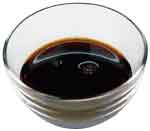 Subscribe to my feed for ingredients
Subscribe to my feed for ingredients  Add to My Yahoo
Add to My Yahoo 
© Copyright 1995-2023, Clay Irving <clay@panix.com>, Manhattan Beach, CA USA
 Subscribe to my feed for ingredients
Subscribe to my feed for ingredients  Add to My Yahoo
Add to My Yahoo
Soy Sauce Characteristics
Pronounced: Soi
Soy sauce originated in China approximately 2,500 years ago. Meat and fish were perserved by packing them with salt. The liquid that leached from the perserved meat was then used as a seasoning (see Fish Sauce). With the introduction of Buddhism in the sixth century BC, a need for a meatless seasoning was created because many of the Buddhists practiced vegetarianism.
In 1254, a Zen priest called Kakushin is attributed to creating a meatless seasoning from a salty paste of fermented grains including soybeans. The priest developed a miso recipe while studying in China, and brought recipe back to Japan. He began making his version and introduced it to others, and accidentally found a liquid residue in the bottom of the container. This liquid is a thick soy sauce called Tamari. Over the years, the Japanese modified the ingredients and brewing techniques to produce a soy sauce with a more balanced flavor that enhanced food flavors. Authentic soy sauce is made from soybeans, wheat, and salt. soybeans are carefully selected and roasted. The roasted soybeans and flour made from roasted wheat are inoculated with a culture of Aspergillus oryzae1. The mash is incubated for three days at 85°F (30°C). During this time, the Aspergillus breaks down starch from the soybeans and wheat flour into simple sugars; hard-to-digest soy proteins into easily absorbed amino acids, and fats into fatty acids. At the end of the three days, the resulting culture is called koji. The koji is mixed with brine (heavily salted water) to produce a mash caled moromi. The moromi is transfered to fermentation tanks for one year. During this time, the "brewing" process (similar to brewing beer) produces lactic acid which drops the pH and makes the mixture more acidic, and alcohol is also produced from the sugars. At the end of the year, the solids, or "cake", are filtered off, and the liquid collected. This liquid is refined, tested, pasteurized, and bottled to produce high-quality soy sauce.
The brewing process causes the soy sauce to contain between 1 and 2% (V/V) alcohol (ethanol). Some naturally brewed soy sauces containing 2% alcohol are imposed a spirit duty.
Varieties
Hopefully, not everyone in the US thinks soy sauce is the salty dark brown liquid that comes in packets with Chinese take out -- That stuff is nasty! It is varying grades of synthetic soy sauce. Soy sauce, just like beer, wine, or balsamic vineger, can range from authentic, top-grade varieties aged in seasoned wooden casks to quickly manufactured, chemically-enhanced off-taste vile substances.
Soy sauce is called "shoyu" in Japan. There are many different types of soy sauces. In Japan, there are five kinds of soy sauces in Japanese (JAS) classifications:
Other types of soy sauces include:
 |
Online Sources
Footnotes
1 Aspergillus is a fungus. There are many different types of Aspergillus fungi, many of which are harmful to humans. Several, however, are beneficial to humans. Aspergillus niger, for example is used to produce citric acid by large scale fermentation. Aspergillus oryzae is used in the fermenation of soy sauce -- It is also used in the fermentation of rice to make sake!
2 Halal is an Arabic word meaning lawful or permitted.
3 Haram is an Arabic word meaning anything that is forbidden by Islamic law.